Curating industry-specific swipe files helps you craft high-conversion emails by analyzing successful campaigns, messaging strategies, and visual elements tailored to your niche. You’ll identify what resonates with your audience, organize effective templates, and keep your content current. Using proven examples saves time and boosts your results. Staying updated on industry trends and collaborating with your team guarantees continuous improvement. Keep exploring, and you’ll discover how to refine your email strategy even further.
Key Takeaways
- Categorize and tag swipe files by industry, campaign type, and success metrics for quick, relevant access.
- Curate high-conversion emails from reputable sources, emphasizing effective subject lines, messaging, and calls-to-action.
- Regularly review and update swipe files to remove outdated examples and incorporate fresh, industry-specific strategies.
- Analyze industry benchmarks and competitor campaigns to identify patterns and optimize your email messaging.
- Incorporate visual branding elements and personalization tactics tailored to each industry to increase relevance and engagement.
Understanding the Power of Industry-Specific Swipe Files
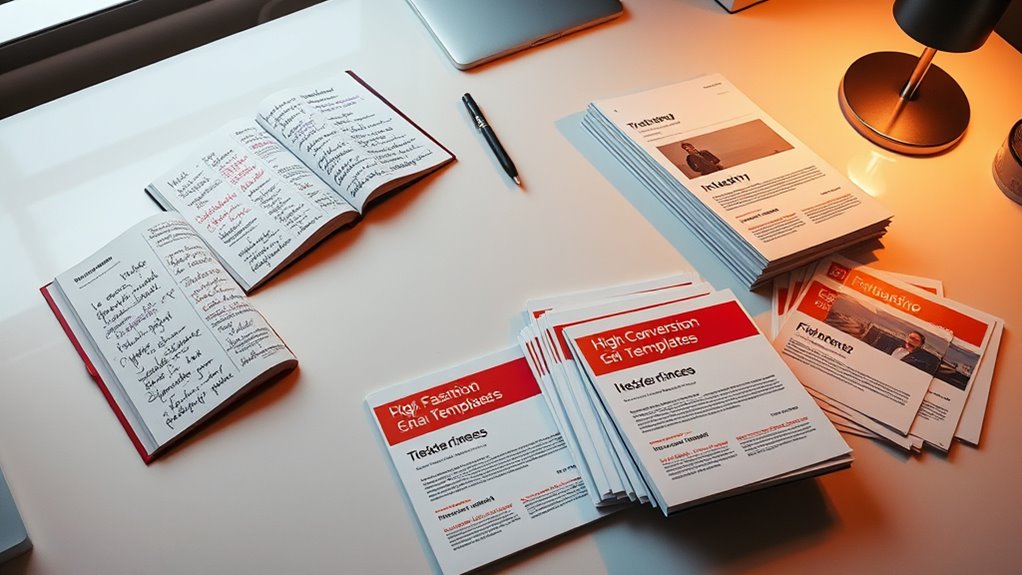
Understanding the power of industry-specific swipe files is essential for crafting high-conversion emails. These files serve as valuable tools, offering targeted insights and proven messaging strategies tailored to your niche. By analyzing successful campaigns within your industry, you can identify effective personalization tactics that resonate with your audience. Industry insights gleaned from these swipe files help you understand what language, offers, and calls-to-action work best. Incorporating this knowledge allows you to craft emails that feel relevant and compelling, increasing engagement and conversions. Rather than starting from scratch, you leverage proven templates and ideas, saving time and boosting your confidence. Additionally, understanding key concepts like contrast ratio can help you craft more visually appealing email content that stands out in crowded inboxes. Ultimately, industry-specific swipe files empower you to send more persuasive, personalized emails that drive results.
Identifying Successful Campaigns in Your Niche

How can you pinpoint the most successful campaigns in your niche? Start by researching industry benchmarks to understand typical open rates, click-through rates, and conversions. This gives you a clear standard for success. Next, perform competitor analysis to see what strategies others are using and which emails stand out. Look for campaigns that consistently outperform industry averages and note their subject lines, messaging, and offers. Pay attention to patterns in timing and segmentation that seem effective. By combining insights from industry benchmarks and competitor analysis, you can identify which campaigns truly resonate with your target audience. Additionally, examining Digital Creativity and Innovation Skills can help you craft more engaging and personalized email content that boosts your campaign performance. This approach helps you focus on proven tactics, ensuring your email efforts are aligned with what’s working in your industry.
Analyzing Key Elements of High-Performing Emails

To create high-conversion emails, you need to focus on their key elements. Compelling subject lines grab attention, while persuasive calls-to-action drive engagement. Analyzing these components helps you craft emails that truly resonate with your audience. Incorporating segmentation of audience ensures that your messaging is targeted and relevant, increasing the likelihood of a positive response.
Compelling Subject Lines
The most effective subject lines share a few key elements that grab attention and entice recipients to open your email. They often leverage personalization tactics and emotional appeals to resonate deeply. Personalization makes your message feel tailored, increasing relevance and curiosity. Emotional appeals trigger feelings like excitement, urgency, or fear of missing out, prompting quicker opens. To craft compelling subject lines, focus on clarity, curiosity, and relevance. Use concise language that sparks interest without giving everything away. Here’s a quick comparison:
| Element | Example | Purpose |
|---|---|---|
| Personalization | “John, exclusive offer inside” | Builds trust and relevance |
| Emotional Appeal | “Don’t miss out on this!” | Creates urgency |
| Clarity | “Save 20% today only” | Sets clear expectations |
| Curiosity | “What you need to know” | Sparks intrigue |
| Relevance | “For busy marketers” | Connects directly to audience |
Additionally, understanding the horsepower of electric dirt bikes can help tailor your messaging to enthusiasts interested in performance features.
Persuasive Call-to-Action
A compelling call-to-action (CTA) is the critical element that turns passive recipients into engaged customers. Your call to action should be clear, direct, and easy to act upon. Use persuasive language that creates urgency or highlights value, making recipients feel they can’t miss out. Phrases like “Get started today,” “Claim your discount,” or “Download now” motivate immediate responses. Focus on benefits rather than features, emphasizing what the customer gains. Keep your CTA visually prominent—buttons or bold text work best. Remember, the goal is to inspire action without overwhelming your audience. A well-crafted call-to-action guides your readers seamlessly toward the next step, increasing conversions and turning your email into a powerful sales tool. Incorporating vetted information ensures your messaging aligns with proven strategies for high engagement.
Collecting and Organizing Your Industry Swipe Files
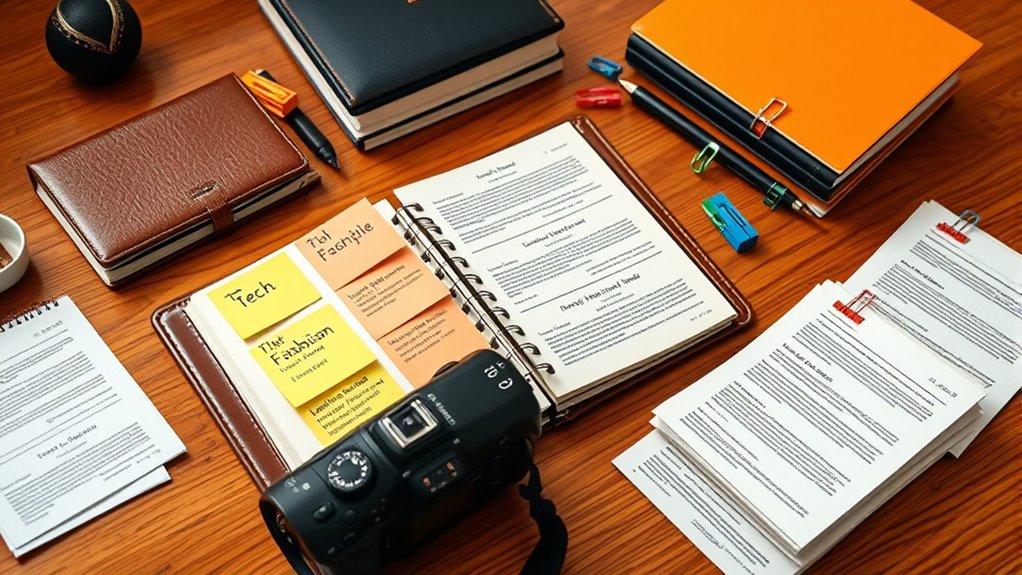
To make the most of your swipe files, you need effective categorization strategies that keep similar emails together for quick reference. Store your files in a way that’s easy to access and update regularly, so your collection stays relevant. Consistently review and refine your organization system to guarantee it continues supporting your evolving industry insights. Incorporating data-driven strategies can help you optimize your collection for measurable results.
Categorization Strategies
Organizing your industry swipe files effectively is essential for quick access and efficient use. Start by categorizing emails based on content diversification, such as promotional offers, storytelling, or customer testimonials. This makes it easier to find specific types of messages when needed. Additionally, organize files by visual branding elements like color schemes, logo placement, and layout styles. Grouping similar visual styles helps you quickly identify trends and adapt successful designs. Consider creating folders or tags for each industry segment, ensuring that related emails are easy to locate. Clear categorization reduces search time and helps you analyze which strategies perform best. By structuring your swipe files around content types and visual branding, you streamline your workflow and enhance your ability to craft high-conversion emails swiftly. Regularly reviewing and updating your categories can also support effective organization and prevent clutter from hindering your efficiency.
Storage Best Practices
Implementing effective storage practices for your industry swipe files guarantees quick retrieval and maintains organization as your collection grows. Use clear folder structures or tagging systems that categorize swipe files by industry, campaign type, or target audience. Incorporate keyword labels like “email personalization” or “visual design” to make searches faster. Store high-quality examples that showcase compelling visuals and personalized messaging, ensuring you can easily reference elements that boost engagement. Digital tools like cloud-based drives or dedicated swipe file apps help keep your collection accessible across devices. Regularly back up your files to prevent loss. Keep your archive uncluttered by removing outdated or irrelevant samples. Proper storage guarantees you can swiftly locate high-converting email templates, supporting efficient campaign development. Additionally, understanding how sound vibrations can influence emotional responses may inspire creative elements in your email designs.
Updating and Maintaining
Regularly updating and maintaining your industry swipe files is essential to keep your collection relevant and effective. As you gather new high-conversion emails, review and remove outdated or less effective examples to stay current. Incorporate personalization strategies by tagging swipe files based on audience segmentation, ensuring you can quickly find emails tailored for specific segments. This practice allows you to adapt your campaigns to evolving trends and audience preferences. Keep your files organized by industry, campaign type, and success metrics, making it easier to identify patterns and inspiration. Consistent updates help you refine your approach, optimize personalization, and craft more targeted, engaging emails that resonate with your audience. Staying proactive ensures your swipe file remains a powerful tool for high-conversion email marketing. Additionally, understanding butter storage and freshness can inspire creative ways to keep your content fresh and appealing.
Adapting Proven Templates to Your Brand Voice
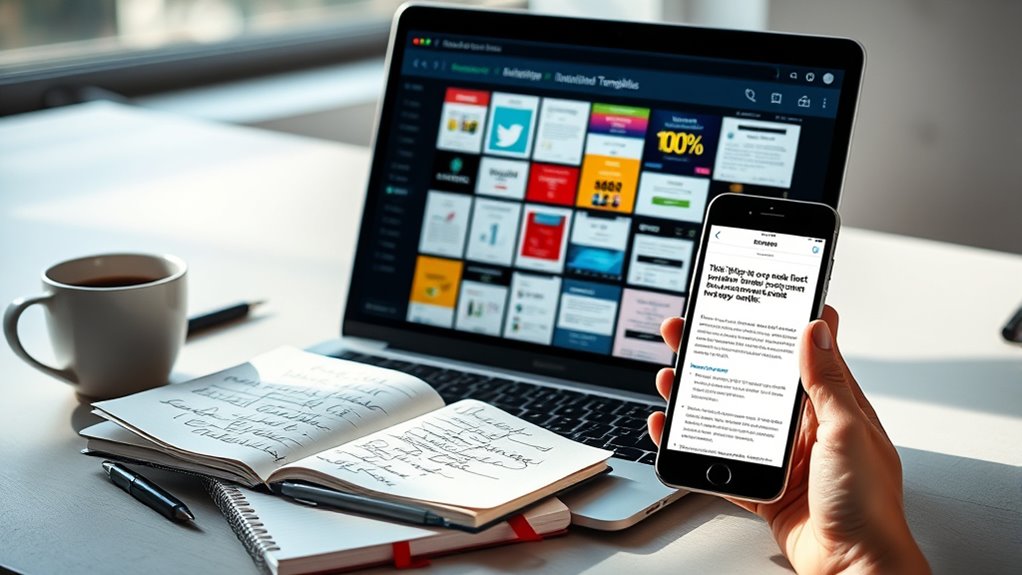
While proven email templates provide a strong starting point, the key to maximizing their effectiveness resides in tailoring them to fit your brand voice. Achieving brand consistency and tone adaptation ensures your emails resonate authentically with your audience. Consider these strategies:
Tailor email templates to your brand voice for authentic audience engagement and consistency.
- Adjust language to match your brand’s personality—formal, casual, or playful.
- Incorporate your brand’s unique terminology and style.
- Maintain consistent messaging across all emails for recognition.
- Personalize greetings and calls-to-action to align with your brand tone.
Testing and Optimizing Your Customized Email Copies
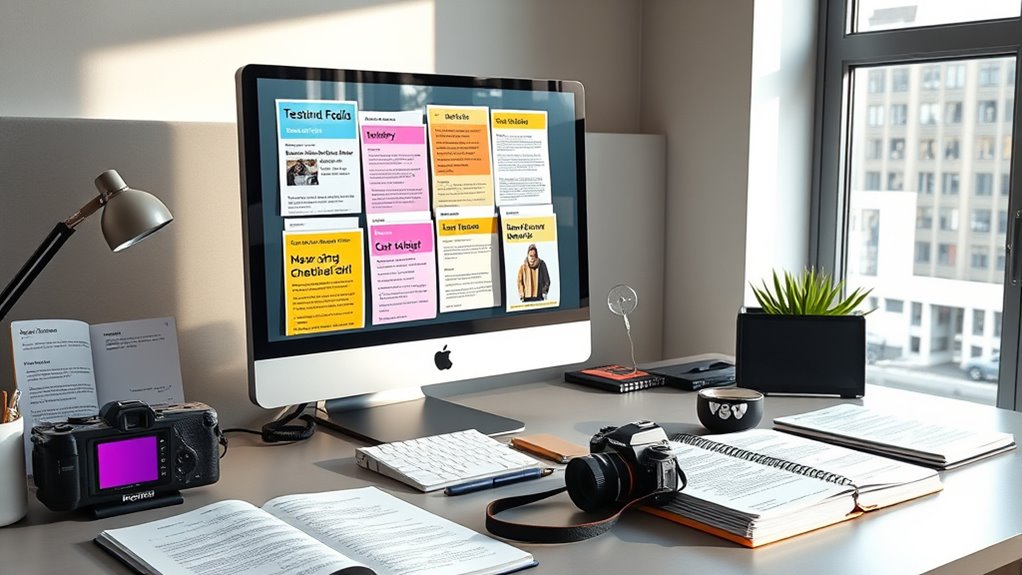
To improve your email performance, start by running A/B tests on different subject lines or calls to action. Keep an eye on key metrics like open rates, click-throughs, and conversions to gauge success. Use these insights to make ongoing, data-driven tweaks that refine your copy for even better results. Regularly reviewing support hours and availability can help you time your outreach for maximum engagement.
A/B Testing Strategies
A/B testing is essential for refining your email campaigns and boosting conversion rates. It helps you identify the most effective elements by comparing different versions. To maximize results, focus on these strategies:
- Test segment personalization to see which message resonates best with specific audience groups.
- Experiment with timing optimization to determine when your audience is most responsive.
- Vary subject lines and call-to-actions to improve open and click-through rates.
- Analyze results carefully, making data-driven adjustments for future campaigns.
Performance Metrics to Monitor
Monitoring key performance metrics is essential for understanding how your customized email copies perform and identifying areas for improvement. Focus on tracking performance benchmarks like open rates, click-through rates, and conversion rates to gauge success. Engagement rates reveal how recipients interact with your emails, helping you assess whether your messaging resonates. Keep an eye on bounce rates and unsubscribe rates as well, since these indicate issues with deliverability or relevance. By consistently analyzing these metrics, you can determine which elements drive results and which need tweaking. This data-driven approach guarantees you’re optimizing your email strategy effectively, leading to higher engagement and better overall performance. Regular monitoring helps you stay aligned with your goals and adapt quickly to audience preferences.
Iterative Copy Improvements
Since email performance can vary with small changes, continuously testing and refining your copy is essential for maximizing results. Focus on how email personalization and audience segmentation influence engagement. Regularly experiment with subject lines, calls to action, and messaging tone to find what resonates best. Use these strategies to improve your email copy iteratively:
- Test different segments to identify high-responsiveness groups
- Personalize content based on audience behavior and preferences
- A/B test subject lines and email layouts for better open rates
- Analyze results to refine your approach and boost conversions
Leveraging Swipe Files for Different Campaign Goals
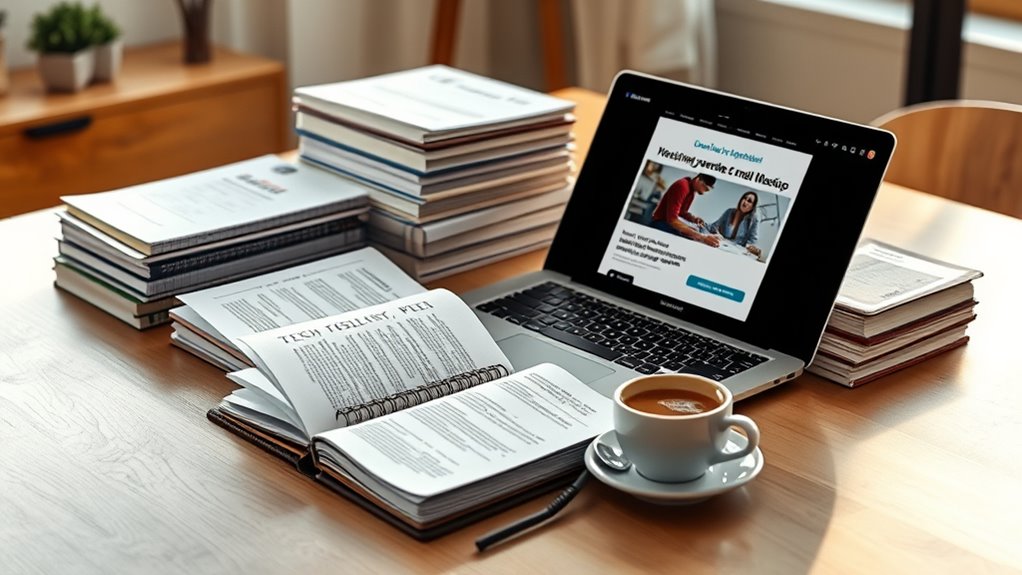
When crafting email campaigns, leveraging swipe files tailored to specific goals can substantially boost your results. By selecting examples aligned with your campaign’s purpose—whether driving sales, nurturing leads, or increasing engagement—you guarantee your messaging resonates. Use personalization tactics from your swipe files to customize subject lines, calls to action, and content that appeals directly to your audience’s interests. Segmentation strategies also come into play; organize your swipe files by demographics, purchase history, or behaviors to match the right message with the right segment. This targeted approach makes your campaigns more effective and efficient. Remember, the key is to adapt proven templates thoughtfully, aligning them with your campaign goals and audience needs for maximum impact.
Staying Updated With Industry Trends and Best Practices

Are you staying ahead of industry trends and best practices to keep your email campaigns competitive? To do so, you must actively monitor industry innovation and leverage trend forecasting. Here are four ways to stay current:
- Subscribe to industry-specific newsletters and authoritative blogs.
- Attend webinars and conferences focused on email marketing developments.
- Join professional groups and online communities for real-time insights.
- Analyze competitors’ campaigns to identify emerging trends and successful strategies.
Sharing and Collaborating on Swipe Files Within Your Team

Sharing and collaborating on swipe files within your team helps guarantee everyone stays aligned and learns from each other’s successes. By organizing regular team brainstorming sessions, you encourage diverse ideas and fresh perspectives, which can inspire new high-conversion email strategies. Feedback sessions are also essential; they allow team members to critique and refine swipe files, ensuring messaging resonates and achieves results. Using shared platforms, like Google Drive or collaboration tools, keeps everyone updated and provides easy access to curated email templates. This collective approach fosters continuous improvement, boosts creativity, and builds a shared knowledge base. Ultimately, collaboration ensures your team leverages collective expertise, making your swipe files more effective and adaptable across different campaigns and industries.
Measuring the Impact of Using Curated Email Templates

To accurately gauge the effectiveness of your curated email templates, you need to track key performance metrics that reflect user engagement and conversion rates. Engagement metrics like open rates, click-through rates, and bounce rates reveal how well your audience responds. Audience segmentation helps you tailor your analysis, identifying which segments interact most with your templates. Focus on these:
- Open rate improvements across segments
- Click-through rate increases from curated templates
- Conversion rate changes after template implementation
- Engagement trends within specific audience segments
Frequently Asked Questions
How Often Should I Update My Industry-Specific Swipe Files?
You should update your industry-specific swipe files regularly to stay ahead of industry shifts. The frequency updates depend on how dynamic your industry is; if trends change fast, consider updating weekly or monthly. For slower industries, quarterly updates might suffice. Staying current guarantees your emails resonate with your audience, incorporate new strategies, and maintain high conversion rates. Keep an eye on industry news to determine the right update schedule.
Can Swipe Files Be Used Across Different Marketing Channels?
You can definitely use swipe files across different marketing channels to support multichannel integration and develop cross-platform strategies. By adapting effective email copy, you create consistent messaging that resonates across platforms like social media, landing pages, and ads. Just make sure you tailor content to each channel’s unique style and audience, which helps maximize engagement and conversion rates while maintaining a unified brand voice throughout your marketing efforts.
What Legal Considerations Are There When Using Swipe Files?
Did you know that 60% of legal disputes involve intellectual property issues? When using swipe files, you must consider intellectual property rights to avoid infringement. Always respect confidentiality agreements and make certain the content you’re using isn’t proprietary or copyrighted. By doing so, you stay compliant with legal standards, protect your brand, and prevent costly lawsuits. Keep these considerations in mind whenever leveraging swipe files to maintain ethical and legal marketing practices.
How Do I Personalize Swipe Files for Different Customer Segments?
To personalize swipe files for different customer segments, start by analyzing your customer segmentation data to identify key interests and behaviors. Then, adapt your email content to match each segment’s preferences, making it more relevant and engaging. Use personalized content that resonates with their needs, ensuring each message feels tailored. This approach boosts engagement and conversion rates by delivering targeted, meaningful emails to each customer group.
Are There Tools to Automate Swipe File Collection and Management?
Think of automation tools like your digital butler, streamlining email organization and swipe file collection. They automatically gather, categorize, and update high-conversion email examples, saving you time and effort. Platforms like HubSpot, Mailchimp, or Trello integrate seamlessly, making swipe file management effortless. With automation, you can focus on crafting compelling emails instead of hunting for inspiration, ensuring your campaigns stay fresh and relevant without manual hassle.
Conclusion
Think of your swipe files as a lighthouse guiding your emails toward success. By studying industry signals, adapting proven templates, and staying current with trends, you illuminate your path to higher conversions. Share these guiding lights with your team to strengthen your collective beam. Remember, your curated swipe files are not just tools—they’re beacons that help your campaigns shine brighter, ensuring your message reaches its destination with clarity and impact.
Natali – Editor in Chief (Strategy and Mastery, AI Expert) Natali, our Editor in Chief, is the driving force behind our content’s strategic direction. With a keen eye for detail and a deep understanding of market trends, Natali ensures that our content is top-notch and strategically aligned with our client’s goals. Her expertise in AI helps to seamlessly integrate advanced technology into our marketing strategies, pushing the boundaries of conventional marketing.









![Personalization Basics: Beyond "Hello [Name]" in Your Emails 31 advanced email personalization techniques](https://leftbrainmarketing.net/wp-content/uploads/2025/11/advanced_email_personalization_techniques_7bop8-260x140.jpg)
